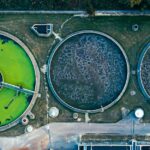
Conditioning & Mixing Tank Agitators – Mining & Mineral Processing
In the dynamic realm of mining and mineral processing, the

Essentially every industry must at some point contend with solids suspension. Whenever a slurry with solid particles is present, the process will require some way to keep those particles suspended. This is key to preventing buildup on tank bottoms and sides. It also plays an important role in providing the required solid-liquid contact for many processes. In most cases, agitators are the chosen method for maintaining solids suspension.
Determining the optimal agitator configuration for solids suspension isn’t a simple process. It takes an understanding of both the solids and liquids involved, along with their complex interactions. Dynamix designs solutions that provide the agitation required to maintain solids suspension for applications within any industry.
Applications that require agitation to prevent solids settling each have their own unique requirements that must be taken into account during the design process. In order to provide an agitator solution that meets these process requirements, it is essential to understand what level of suspension a process calls for.
Partial suspension is the absolute minimum requirement to prevent solids buildup. In a product that is partially suspended, all solids are in motion, even those touching the bottom of the vessel. However, any process aiming for the absolute minimum suspension possible is particularly susceptible to buildup at the edges of the tank floor.
Off-bottom suspension is more commonly the minimum mixing requirement for any process where solid-liquid contact is a design requirement. While the product does not have a uniform distribution of solids throughout, particles are no longer sustaining contact with the bottom of the tank. As agitation is increased, the product will eventually reach a point of uniform suspension where the distribution of solid particles is the same at any point in the tank.
At first glance, one might think that the primary factor in agitation is the impeller speed. In fact, increasing the impeller speed is often an inefficient and ineffective way to increase suspension. Impellers with a small diameter that operate at high rpm don’t generate a sufficient area of influence to maintain a uniform distribution or prevent buildup at the tank edges.
Instead, an impeller with a larger diameter and a lower speed is often the most effective approach. With low rpm and high torque, the impeller generates a much larger area of influence. The axial pumping prevents solids settling on the tank floor and promotes a homogeneous mixture throughout the entire tank.
While the agitator configuration is critical, the tank design also plays an integral role in solids suspension. The aspect ratio of the tank will influence solids settling, along with the shape of the bottom as well. In many cases, tank designs will incorporate baffles to provide better flow patterns.
Designing an effective agitation solution for solids suspension takes expert insight and years of industry experience. Our Dynamix engineers can develop the optimal solution for your process, delivering effective and efficient agitation to ensure your product quality. You can contact our team today to find out more about our solids suspension solutions.

In the dynamic realm of mining and mineral processing, the

Mining operations are essential for meeting the world’s resource needs, yet they

Water treatment is a complex yet vital process that ensures
Subscribe to our newsletter for helpful technical publications and industry announcements.

This website uses cookies to ensure you get the best experience on our website